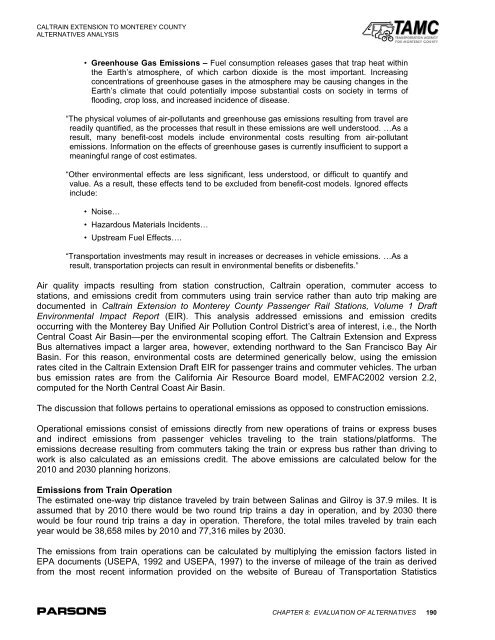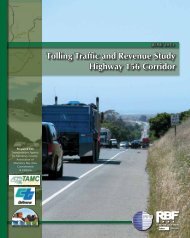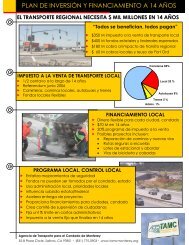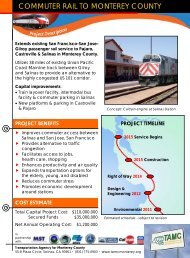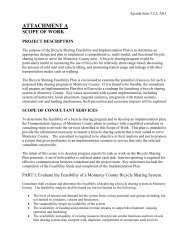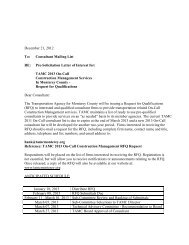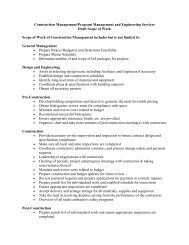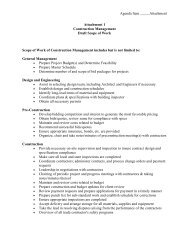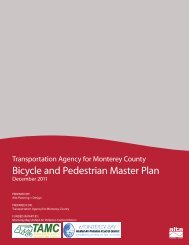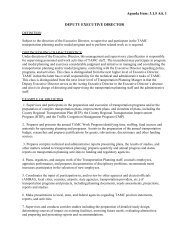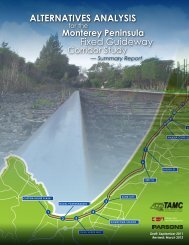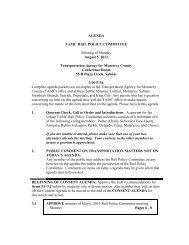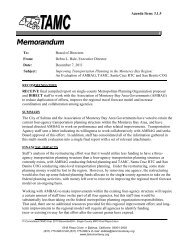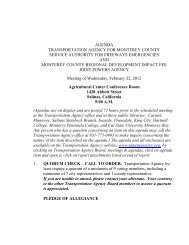Commuter Rail Extension Alternatives Analysis - Transportation ...
Commuter Rail Extension Alternatives Analysis - Transportation ...
Commuter Rail Extension Alternatives Analysis - Transportation ...
You also want an ePaper? Increase the reach of your titles
YUMPU automatically turns print PDFs into web optimized ePapers that Google loves.
CALTRAIN EXTENSION TO MONTEREY COUNTYALTERNATIVES ANALYSIS• Greenhouse Gas Emissions – Fuel consumption releases gases that trap heat withinthe Earth’s atmosphere, of which carbon dioxide is the most important. Increasingconcentrations of greenhouse gases in the atmosphere may be causing changes in theEarth’s climate that could potentially impose substantial costs on society in terms offlooding, crop loss, and increased incidence of disease.“The physical volumes of air-pollutants and greenhouse gas emissions resulting from travel arereadily quantified, as the processes that result in these emissions are well understood. …As aresult, many benefit-cost models include environmental costs resulting from air-pollutantemissions. Information on the effects of greenhouse gases is currently insufficient to support ameaningful range of cost estimates.“Other environmental effects are less significant, less understood, or difficult to quantify andvalue. As a result, these effects tend to be excluded from benefit-cost models. Ignored effectsinclude:• Noise…• Hazardous Materials Incidents…• Upstream Fuel Effects….“<strong>Transportation</strong> investments may result in increases or decreases in vehicle emissions. …As aresult, transportation projects can result in environmental benefits or disbenefits.”Air quality impacts resulting from station construction, Caltrain operation, commuter access tostations, and emissions credit from commuters using train service rather than auto trip making aredocumented in Caltrain <strong>Extension</strong> to Monterey County Passenger <strong>Rail</strong> Stations, Volume 1 DraftEnvironmental Impact Report (EIR). This analysis addressed emissions and emission creditsoccurring with the Monterey Bay Unified Air Pollution Control District’s area of interest, i.e., the NorthCentral Coast Air Basin—per the environmental scoping effort. The Caltrain <strong>Extension</strong> and ExpressBus alternatives impact a larger area, however, extending northward to the San Francisco Bay AirBasin. For this reason, environmental costs are determined generically below, using the emissionrates cited in the Caltrain <strong>Extension</strong> Draft EIR for passenger trains and commuter vehicles. The urbanbus emission rates are from the California Air Resource Board model, EMFAC2002 version 2.2,computed for the North Central Coast Air Basin.The discussion that follows pertains to operational emissions as opposed to construction emissions.Operational emissions consist of emissions directly from new operations of trains or express busesand indirect emissions from passenger vehicles traveling to the train stations/platforms. Theemissions decrease resulting from commuters taking the train or express bus rather than driving towork is also calculated as an emissions credit. The above emissions are calculated below for the2010 and 2030 planning horizons.Emissions from Train OperationThe estimated one-way trip distance traveled by train between Salinas and Gilroy is 37.9 miles. It isassumed that by 2010 there would be two round trip trains a day in operation, and by 2030 therewould be four round trip trains a day in operation. Therefore, the total miles traveled by train eachyear would be 38,658 miles by 2010 and 77,316 miles by 2030.The emissions from train operations can be calculated by multiplying the emission factors listed inEPA documents (USEPA, 1992 and USEPA, 1997) to the inverse of mileage of the train as derivedfrom the most recent information provided on the website of Bureau of <strong>Transportation</strong> Statisticsparsons CHAPTER 8: EVALUATION OF ALTERNATIVES 190


